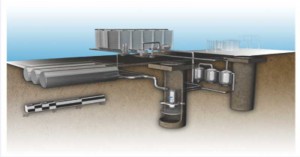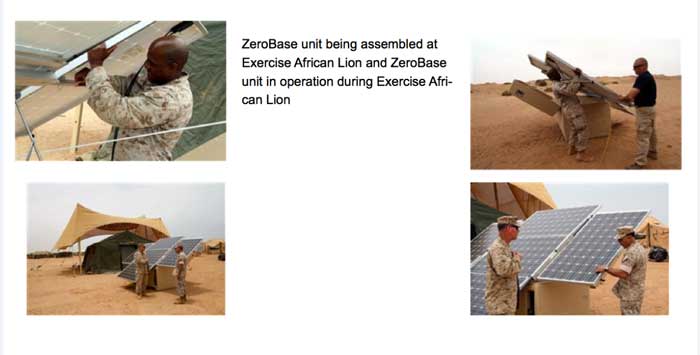Delivering Energy at the Tip of the Spear (Part Two)
Deployable, Portable Renewable Power Units are Ready Today
By Hon. Bill Anderson
This posting is the second of a three part posting of the Honorable Bill Anderson’s examination of how to deliver energy to the deployed warfighter. By enhancing the ability of the deployed force to self-sustain, a revolution in combat logistics can be generated. With the third posting, the complete article will be published as a SLD special report in PDF format for downloading by readers.
***
10/08/2010 – The US Marines have been testing a deployable sustainable energy system utilizing solar and/or wind energy generation and combining with energy storage capacity and sophisticated energy management capability. The units being tested by the Marines were developed and are manufactured by ZeroBase Energy, LLC.
This technology has been developed to date entirely via private sector funding with no grants from DoD. The system, when combined with a portable SLMCO water purification unit, is capable of purifying water in addition to providing energy for lighting and to power electronic equipment. The water purification system can take water from almost any source and via reverse osmosis provide clean drinking water for the war fighter.
Zerobase Unit Being Assembled
Credit Photo: Zerobase, USMC
ExFOB
Called the Expeditionary Forward Operating Base program or ExFOB, ZeroBase was tested at exercise African Lion in Morocco in May. Stated purposes of ExFOB:
- cut down on consumption of fossil fuels,
- help protect the environment,
- improve safety of overseas operations,
- improve comfort for Marines operating in the FOB environment.
African Lion allowed the Marines to test this equipment that is capable of supporting the ExFOB concept in harsh environments similar to what will be experienced in the battle space. Equipment faced sand, dust and significant fluctuations in temperature during the exercise.
Based on tests conducted to date, it appears that the equipment is capable of assembly, maintenance and disassembly by deployed forces and has shown the capability to generate power as specified. Testing is expected to continue at Extended Mohave Viper at Twentynine Palms, CA this summer.
For the perspective of the war fighters who lived with these units in the field, refer to the Marine Corps blog.
Again, using General Powell’s logic, based on what we know today, why have we not gone to “all hands on deck” to accelerate the testing of the ZeroBase and any other deployment-ready unit by all Services. The units must be fielded as quickly as possible, while at the same time providing a streamlined approach for all potential vendors to get their complementary products tested and in the field. This is especially true where those vendors are willing to self-fund development and are paid based on power produced. The result…convoy vehicles off the roads for good.
The “Nuclear Option”
And what about the near-term horizon? What other emerging technologies offer promise in addressing this critical need? The military is clearly looking down the road for various options to meet the requirement for deployable alternative energy generation systems.
On March 30, 2010, the Defense Advanced Research Projects Agency (DARPA) issued a Request for Information in search of innovative technologies that will enable the development of deployable nuclear reactor technologies for the generation of electrical power and military logistics fuel. This focus on nuclear power to meet land-based military need is certainly not new. The military has decades-long experience with fixed base operation of small nuclear reactors.
And, during my time in the Pentagon, we in the Air Force leadership were tasked by Members of Congress in 2007 to take a serious look at whether Small Modular Reactors (SMRs) offered promise to operate military bases as “energy islands” eliminating the risks associated with grid failure. We learned that technologies under development in the US private sector could be within a couple of years of commercial deployment.
In addition, several designs suggested that units in the range of 10-35 megawatts electrical output (the size range most appropriate for a US fixed military installation) could be developed and deployed in the relative short term. As we continued our investigation, it became clear that transportable/deployable small nuclear units were also within reach.
During my time in the Pentagon, we in the Air Force leadership were tasked by Members of Congress in 2007 to take a serious look at whether Small Modular Reactors (SMRs) offered promise to operate military bases as “energy islands” eliminating the risks associated with grid failure. We learned that technologies under development in the US private sector could be within a couple of years of commercial deployment. In addition, several designs suggested that units in the range of 10-35 megawatts electrical output (the size range most appropriate for a US fixed military installation) could be developed and deployed in the relative short term. As we continued our investigation, it became clear that transportable/deployable small nuclear units were also within reach.
The intention of the DARPA RFI is to identify technologies applicable in areas without a robust grid, not easily accessible for fuel resupply, and that are designed to operate for several years without refueling. The criteria noted above seem to describe attributes critical for a power generating system appropriate for a remote forward operating location.
Desired characteristics for a realistic nuclear power unit capable of deployment would include:
- A design based on a well-developed technology
- A non-weapons grade fuel source
- A safe and easy to use operating system
- A unit that can be moved to where needed and easily removed when the mission is complete…which would mandate a unit requiring minimal field construction…and capable of being transported by the available transport system.
- Power outputs compatible with specific mission need

Though the DARPA RFI is seeking technologies that could facilitate the development of deployable nuclear power units, in reality, a set of designs and systems already exist. In fact, various designs and technologies that would easily lend themselves to a deployable/transportable reactor have been studied for over 50 years.
In addition, small reactors in various configurations have seen service for decades. What is needed is the opportunity to build and field test units already developed by the private sector to demonstrate the fitness of these designs to meet the requirements of the military in harsh battle and humanitarian relief environments.
Several US companies have been working to bring various designs for small reactors to the marketplace. The technologies vary from simply downsizing the very familiar light water reactor to introducing to the market for the first time technologies like the Liquid Metal Fast Reactor known for decades to DoE but not yet deployed in the US commercial marketplace. These new reactor designs are referred to as Small Modular Reactors (SMRs) and are sized at 300 megawatts or below. Recently, the concept of the Mini Power Reactor (MPRs)…under 50 megawatts in capacity…is gaining interest.
One company in particular receiving attention is Hyperion Power Generation out of Los Alamos, New Mexico. Hyperion has been perfecting the design of a 25 megawatt electric generation unit that is compact, one piece, loaded and sealed at the factory and transportable.
Sometimes referred to as a “nuclear battery” the power unit is about the size of a hot tub. This output is compatible with power needs of a fixed military base in the US. What may be even more exciting is the possibility of even smaller units…the size of a trash can…with the capability to supply power for military field operations…transportable by Humvee, MRAP, helicopter or fixed-wing transport aircraft directly to a forward operating base.
Nuclear power generation carries with it the added complexity of licensing and regulation by the Nuclear Regulatory Commission (NRC). And, military applications on base and down range present some very different applications of the technology than have been considered before. Fortunately, the drafters of the Atomic Energy Act had the foresight to exempt the DoD and DoE from NRC licensing under certain circumstances…allowing for the development, testing and deployment of nuclear power units for the exclusive use of DoD and DoE on their installations. Now, this exemption is not a free pass to deploy untested technologies on every US military base across the world…the DoD has the obligation to permit nuclear installations on their sites, and has done so in the past.
However, this authority does allow for the thoughtful and careful deployment of these new technologies to meet particular military and national security challenges, and can be done so under the watchful eye of the NRC…which should facilitate a more streamlined licensing process for these new machines as they move toward commercial application.


